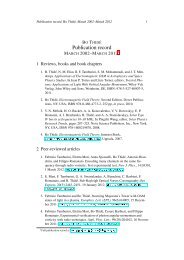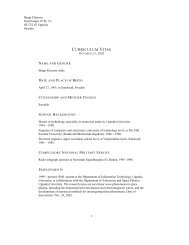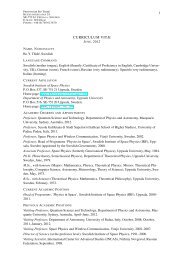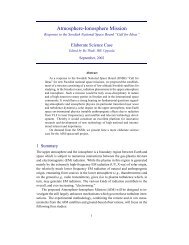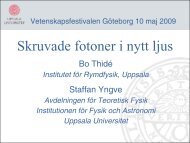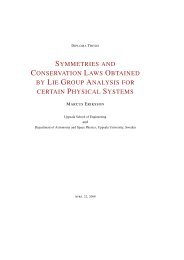Towards a covariant formulation of electromagnetic wave polarization
Towards a covariant formulation of electromagnetic wave polarization
Towards a covariant formulation of electromagnetic wave polarization
You also want an ePaper? Increase the reach of your titles
YUMPU automatically turns print PDFs into web optimized ePapers that Google loves.
2.3. IRREDUCIBLE REPRESENTATION 19<br />
associate a vector to the anti-symmetric part <strong>of</strong> the matrix. This means that<br />
we can write the spectral density matrix in the following way<br />
⃗F ⊗ ⃗ F † = 1 3 Iδ ij + iɛ ijk v k + Q ij , (2.87)<br />
where I is a real scalar, ⃗v is the real dual pseudo-vector (associated to the antisymmetric<br />
imaginary part, see Eq. (2.63) ) and Q is a real symmetric tensor (the<br />
anti-symmetric part is contained in ɛ ijk v k ). This way <strong>of</strong> representing a tenor is<br />
termed an irreducible tensor representation (see e.g. Sakurai [20] and Arfken<br />
& Weber [10]). Since I and Q are real valued we know that ⃗v must contain the<br />
imaginary part. Hence,<br />
⎛<br />
⎞<br />
0 Im[F 1 F2 ∗ ] Im[F 1 F3 ∗ ]<br />
ɛ ijk v k = ⎝Im[F 2 F1 ∗ ] 0 Im[F 2 F3 ∗ ] ⎠ , (2.88)<br />
Im[F 3 F1 ∗ ] Im[F 3 F2 ∗ ] 0<br />
which gives<br />
⃗v = ( Im[F 2 F ∗ 3 ], Im[F 3 F ∗ 1 ], Im[F 1 F ∗ 2 ] ) . (2.89)<br />
To get ⃗v in terms <strong>of</strong> ⃗ F , we look at one component <strong>of</strong> ⃗ V , say V 3 (see Eq. (2.66))<br />
V 3 = i(F 1 F ∗ 2 − F 2 F ∗ 1 ) = i2i(b 1 a 2 − a 1 b 2 ) = −2Im(F 1 F ∗ 2 ) = 2Im(F 2 F ∗ 1 ). (2.90)<br />
And similarly for the other two components. We want ⃗v to be the imaginary<br />
part and thus we get<br />
⃗V = 2 ( Im(F 3 F ∗ 2 ), Im(F 1 F ∗ 3 ), Im(F 2 F ∗ 1 ) ) = −2⃗v. (2.91)<br />
Rewriting ⃗v in terms <strong>of</strong> ⃗ F we have the following expression for ⃗v<br />
⃗v = i [<br />
(F3 F2 ∗ − F 2 F3 ∗ ), (F 1 F3 ∗ − F 3 F1 ∗ ), (F 2 F1 ∗ − F 1 F2 ∗ ) ]<br />
2<br />
= ( − Im(F 3 F ∗ 2 ), −Im(F 1 F ∗ 3 ), −Im(F 2 F ∗ 1 ) ) = − i 2 ⃗ F × ⃗ F † . (2.92)<br />
Comparing ⃗v with V ⃗ , we have that ⃗v defines left-handed and right-handed circular<br />
<strong>polarization</strong> as seen by an observer receiving the <strong>wave</strong> (standing in the<br />
direction <strong>of</strong> propagation), the size <strong>of</strong> this vector, ⃗v is 1 π<br />
times the area <strong>of</strong> the <strong>polarization</strong><br />
ellipse (see Lindell [14]). The relation between ⃗v and Stokes parameter<br />
V is (compare with Equation (2.69))<br />
√<br />
|V| = 2 v1 2 + v2 2 + v2 3 = |2⃗v|. (2.93)<br />
By subtraction we get Q from Equation (2.87), and we have<br />
⎛<br />
F1 2 − 1 3 I 1<br />
2 (F 1F2 ∗ + F 2 F ∗ 1<br />
1 )<br />
2 (F ⎞<br />
3F1 ∗ + F 1 F3 ∗ )<br />
Q = ⎝ 1<br />
2 (F 1F2 ∗ + F 2 F1 ∗ ) F2 2 − 1 3 I 1<br />
2 (F 3F2 ∗ + F 2 F3 ∗ ) ⎠ . (2.94)<br />
1<br />
2 (F 3F1 ∗ + F 1 F3 ∗ 1<br />
)<br />
2 (F 3F2 ∗ + F 2 F3 ∗ ) F3 2 − 1 3 I<br />
We see that ⃗v contains the imaginary part <strong>of</strong> the matrix ⃗ F ⊗ ⃗ F † and that Q is<br />
real valued and symmetric.





